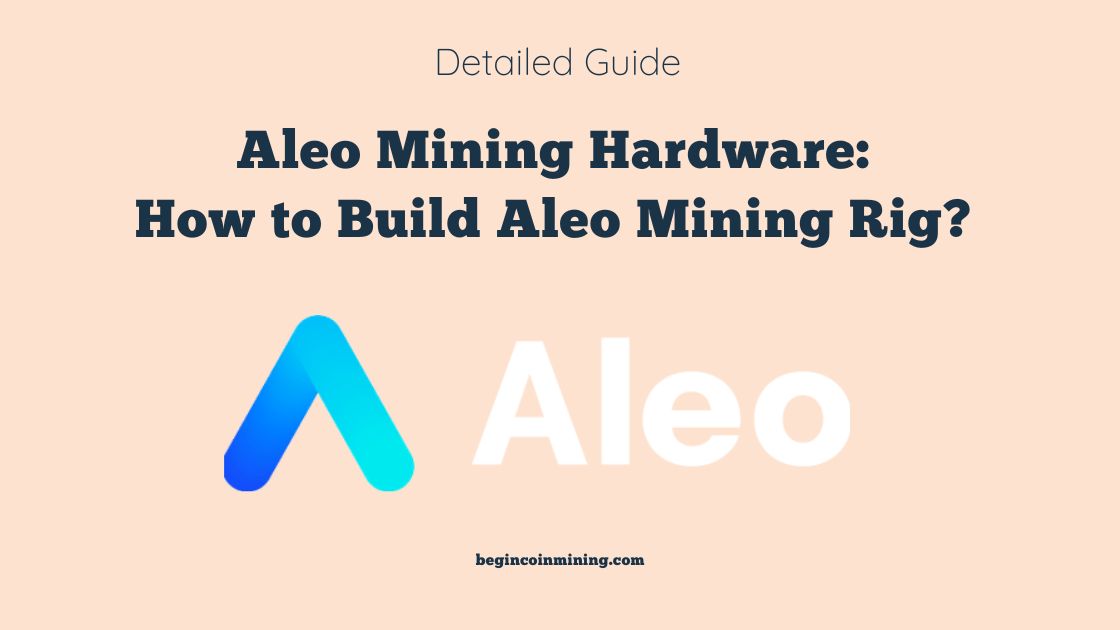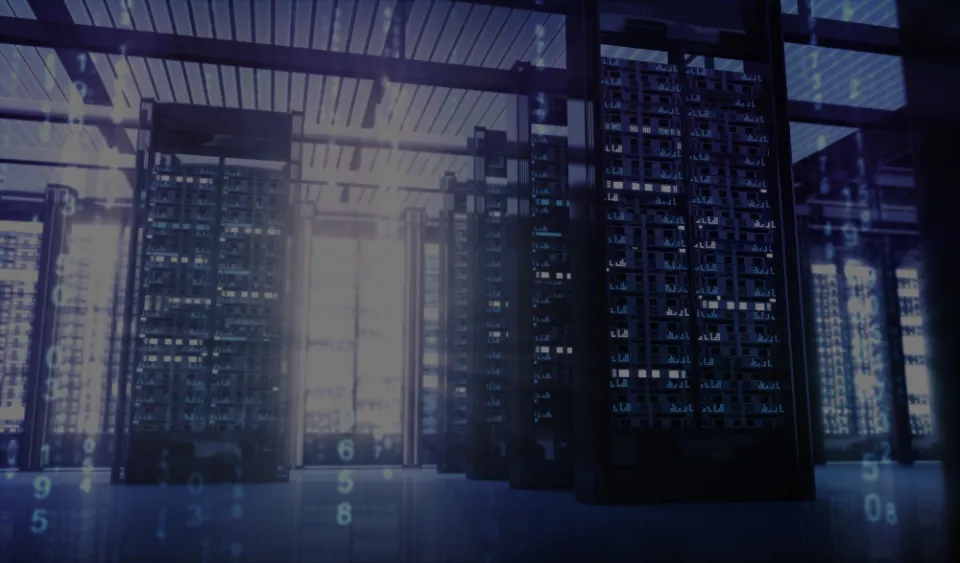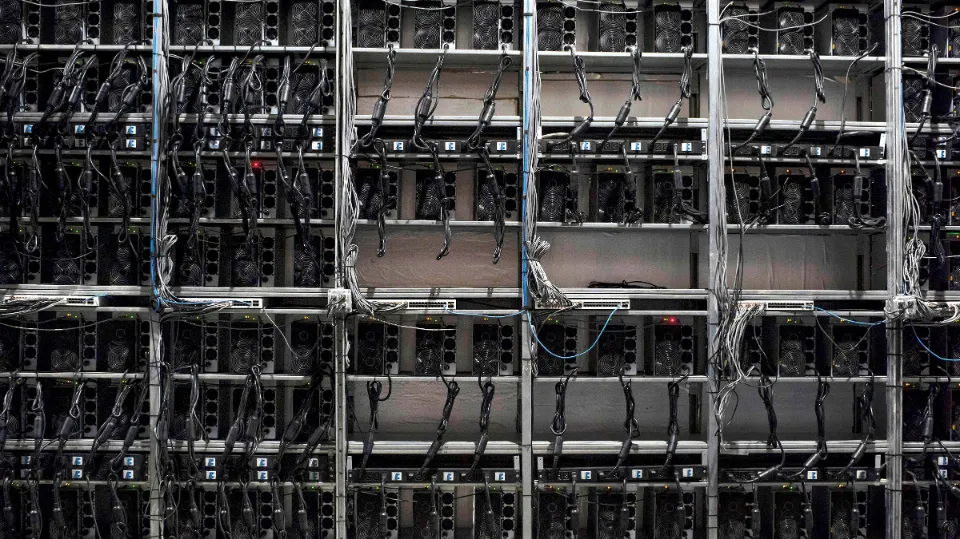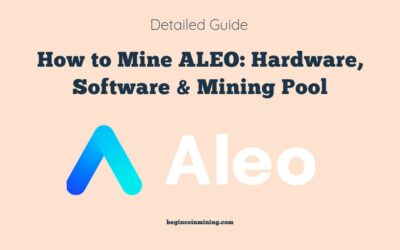Discover what should be considered before building your own ALEO mining hardware, the key components required, and the assembly of an ALEO mining rig.
ALEO adopts the POW mining method, the combination of CPU+GPU, and the CPU participates in collaborative computing, so there are certain requirements for the CPU. The overall ALEO Mining hardware standards are as follows:
- GPUs: 3070, 3080, 3090
- CPU: 16 cores and 32 threads, main frequency not less than 2.5Ghz, 14nm and below process is preferred
- RAM: 16GB, DDR4
- Storage: 128G
- Network: 50 Mbps
Here are the basic steps to build an Aleo miner to start mining:
- Evaluate the costs and viability of constructing an Aleo miner.
- Find and buy the necessary components.
- Build the Aleo miner.
- Software for mining should be chosen and installed.
- Organize a wallet and sign up for a mining pool.
- Start mining aleo.
- Monitor the condition of your Aleo miners.
This blog is based on the technical analysis of the ALEO project, and provides guidance on the selection of Aleo mining machine hardware for investment research institutions, mining machine manufacturers, and miner users. Since it is aimed at a specific group of people, the basic information of ALEO will not be repeated here. The article goes straight to the topic inlcuding ALEO mining hardware building, and model selection.
What is ALEO Mining
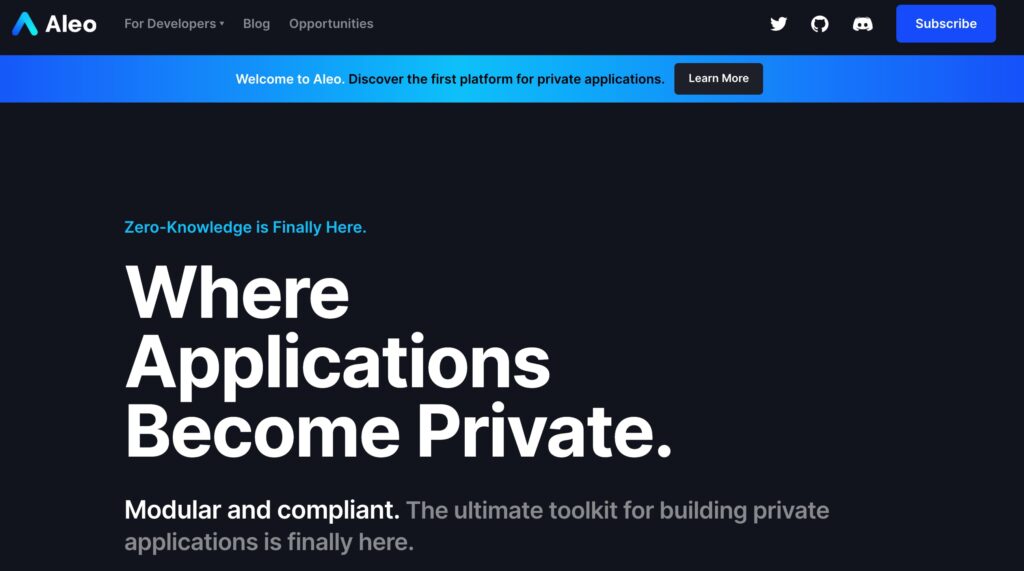
ALEO adopts the PoSW (POS+POW) consensus algorithm, which is generally understood as pledge + mining, and is the mainstream consensus method in the web3 privacy computing track. At this stage, ALEO is in the TEST3 testing period. Only the POW reward test is open and does not involve the POS pledge part. During the test, the faucet may be used to receive the test coins, but the modular stage test may also be adopted.
Compared with the same track, the same type, and the same PoSW project, taking PHA as an example, the pledge and computing power mining methods are adopted. The computing power of the mining machine determines the amount of pledge, but the final rate of return depends on the online stability time, pledge State and other comprehensive factors are jointly determined.
This means that the computing power of the mining machine is only competitive during the current test period. After the official online launch, the computing power of a single machine will no longer have a decisive advantage. Under the same equipment and stable operating conditions, the amount of pledge determines the final output income Rate. Hope all manufacturers and mining users treat it with caution!
ALEO Mining Hardware Factors Considered
The following are the Aleo mining hardware selection factors.
Hardware Versatility
When the computing power explodes after running for a period of time and cannot continue to mine ALEO, the mining machine needs to support mining other currencies. The CPU and GPU can be flexibly used to lay out other projects, which means that the hardware is as general as possible, non-customized, and non-OEM. Select the mainstream configuration to realize universal and flexible switching projects of equipment.
Hardware Redundancy
Under the premise of versatility, while mining ALEO, there is performance redundancy, and low-performance projects can be deployed at the same time, such as aptos, sui, and chia, which basically do not require configuration. It can realize multiple mining with one machine and increase income.
Hardware Energy Consumption Ratio
Choose the solution with the best energy consumption ratio, and avoid purchasing low-priced but high-energy-consuming hardware, such as Gemini and Quadruple Star servers.
Hardware Purchase
Buy old instead of new. If you can buy a second-hand mining hardware for ALEO mining, you will never buy a new;
- Do not buy mining machine hardware that does not provide quality assurance channels. For second-hand mining machine hardware, either promise a long warranty period, or provide a channel for paid maintenance, otherwise do not purchase. The maintenance period must be agreed upon. In the first two years of repairing the video card, it may take half a year at most before returning it to the repairer.
- Fast delivery in bulk. Whether it can be purchased in batches in a short period of time, and the goods will arrive quickly, and the supply of goods will be sufficient when continuing to purchase;
- There is no premium, and the price is close to the market price or slightly lower, and there is no price increase for special models. It is not recommended to purchase hardware such as AMD7950, RTX4090, etc. This kind of hardware needs to be purchased at an increased price at this stage, and it is necessary to find relationships and channels. Increased costs mean reduced ability to resist risks.
Hardware Preservation Rate
When there is an irresistible risk and the equipment must be realized, the secondary sale of hardware is very important. The price of second-hand hardware and the loss caused by depreciation directly affect the overall return on investment. Try to choose hardware with a high value retention rate for ALEO mining, and follow the following rules in terms of value retention rate:
Preservation rate: home desktop > server > high-end customized machine
Therefore, try to choose a home desktop machine in the mining machine plan.
Hardware Liquidity
On the basis of the preservation rate, the difficulty of bulk shipments should also be considered. If 100 units are released at once, does anyone want it? For example, if you sell 50 devices on the premise of the same value preservation rate, intel I7 and I9 machines will be taken away immediately after being processed casually. AMD3995 and 3990 high-end equipment will be sold sporadically for a few months, which is also very valuable, but it is not easy to sell in batches. There is not much demand in the market. Liquidity follows the following rules:
Liquidity: medium allocation > high allocation > low allocation
Therefore, try to choose mid-range configurations for Aleo mining such as Intel 10th generation, 11th generation I7, I9, AMD 5950, 5900 in the plan.
Components for Building a ALEO Miner
Aleo mining equipment requires the following parts, which are listed below.
CPU
- Desktop level > Server level > Workstation level
- Desktop level: Intel 10th generation 11th generation I7, I9, AMD 5950, 5900
- Server Grade: AMD7XX2, Intel Gold/Silver/Bronze
- Workstation Grade: Junk E5
- Recommended: intel-I9-10850K, amd-5950, amd-7402
MotherBoards
- Enhanced power supply: The ALEO mining machine must have a motherboard with enhanced power supply. Some projects run CPU overclocking to increase the load. Insufficient power supply leads to downtime from time to time. If you don’t understand, you can judge by the number of CPU power supply sockets. CPU power supply usually has two sockets, 8pin+ 4pin or 8pin+8pin strengthen the power supply, while the common motherboard CPU power supply has only one 8pin socket.
- PCIe slot: The motherboard for Aleo mining must contain 2 or more PCIEx8/x16 slots. Considering later use, it must have 2 or more PCIE-x8/x16 interfaces, such as the need for multiple graphics cards, multiple chia connections to hard disk pass-through cards, and AR connections to PCIE network cards. , all need to use x8 or x16 interface.
- Onboard M.2 interface: It must contain 1 or 2 M.2 slots. Some projects need to use data storage, and the read and write speed of the stack has requirements. You need to use 1t-2t M.2 to be directly inserted into the motherboard, eliminating the need to use an adapter card to occupy the PCIE slot Location.
- Brand selection: According to long-term technical operation and maintenance experience, the desktop level chooses ASUS > Gigabyte > MSI > others, and the server level chooses AMD > intel > Inspur > others.
- Do not use x79, x99
Memory
- Frequency: There is not much difference in the use of projects without special requirements. It is not recommended to buy 4000 frequency memory at a high price for aleo mining.
- Brand: Performance Corsair, stable Kingston. Pay attention to the purchase channel, there are many fakes in the market.
- Do not buy DDR3, DDR5 is not recommended.
Hard Disk
- System disk: 128G M.2 (nvme protocol, do not buy sata protocol), 128G SSD, M.2 is recommended, if the motherboard slot is not enough, choose to buy SSD.
- Data disk: 1T/2T M.2 (nvme protocol, do not buy sata protocol), SSD is not recommended for Aleo mining.
Graphics Card
- Model: NVIDIA 2 series/3 series can be used, recommend 3090>3080>3070.
- After sales: Here it must be emphasized again that after-sales service is fine, it is okay to buy a Aleo mining card, whether to buy a new one or not, it is no problem, you must agree on the warranty and maintenance time!
Power Supply
Calculate the load power of the whole Aleo mining machine, CPU+mainboard+fan+full graphics card power, add 150w on this basis, for example, 2 card 3070 machine power 500w, at least choose a 650w power supply.
The power supply is an exception for hardware purchases. It is recommended to buy new ones rather than second-hand ones. The stable output is not easy to burn the machine.
Chassis
Professional miners have a lot of mining needs, buy a 2u or 4u standard chassis with a hard disk, the hard disk motherboard must be directly connected to the chip. Do not buy a split type, you need to insert an extra pass-through card to waste the PCIE space of the device, and also cost money.
Non-professional miners and individual users directly recommend open racks, which have good heat dissipation and low cost.
How to Build Your Aleo Mining Rig
ALEO adopts the POW mining method, the combination of CPU+GPU, and the CPU participates in collaborative computing, so there are certain requirements for the CPU. The overall ALEO Mining hardware standards are as follows:
- GPUs: 3070, 3080, 3090
- CPU: 16 cores and 32 threads, main frequency not less than 2.5Ghz, 14nm and below process is preferred
- RAM: 16GB, DDR4
- Storage: 128G
- Network: 50 Mbps
This configuration can be equipped with 2-3 graphics cards. On this basis, each additional graphics card will add 4 cores of CPU and 4G of memory.
Based on the above hardware selection rules, the following recommended configurations are given in combination with other factors while satisfying ALEO mining.
Configurations 1: INTEL desktop +2GPU (general purpose)
| CPU | intel i9-10850k |
| Motherboard | ASUS Z590-E |
| Memory | 16G*2 DDR4 3200Ghz |
| System Disk | 128G NVME |
| Graphics Card | 3090 * 2 |
Configurations 2: AMD desktop +2GPU (general purpose)
| CPU | AMD 5950x |
| Motherboard | ROG STRIX B550-E GAMING |
| Memory | 16G*2 DDR4 3200Ghz |
| System Disk | 128G NVME |
| Graphics Card | 3090 * 2 |
Configurations 3: INTEL server-class +8 GPU (computing power type)
| CPU | 4028GR-TR |
| Motherboard | intel e5-2682v4 * 2 |
| Memory | 16G*4 DDR4 2400Ghz |
| System Disk | 128G NVME |
| Graphics Card | 3090 * 8 |
Aleo Mining Rig Conlusion
Here are the basic steps to build a mining equipment using DIY pre-built components to mine ALEO:
- Evaluate the costs and viability of constructing an Aleo miner. Calculate the profitability while taking into account all associated costs, such as those for mining hardware, electricity, and software.
- Find and buy the necessary components. Purchase the basic parts, including the rig frame, RAM, printed circuit boards, PSU, hashboards, heatsinks, cooling fans, and RAM.
- Build the Aleo miner. Attach the fans, assemble the rig frame, place the PCB and hasboards, and connect the PSU.
- Software for mining should be chosen and installed. Install the mining program you’ve chosen for the particular cryptocurrency.
- Organize a wallet and sign up for a ALEO mining pool. Create a cryptocurrency wallet, then look for a secure mining pool to join.
- Start mining Aleo. Connect to the blockchain network, and begin mining Aleo.
- Monitor the condition of your Aleo miners. Monitor the condition of your Aleo miners, track the temperature, clean the devices from dust, and ensure heat dissipation.
Friendly reminder, don’t blindly believe in market propaganda. Don’t blindly pursue the first mining and ignore the risks. Design a reasonable, healthy, and risk-controllable investment strategy on Aleo mining rig based on your own resource conditions. Sustainable development is the top priority in the blockchain industry!

